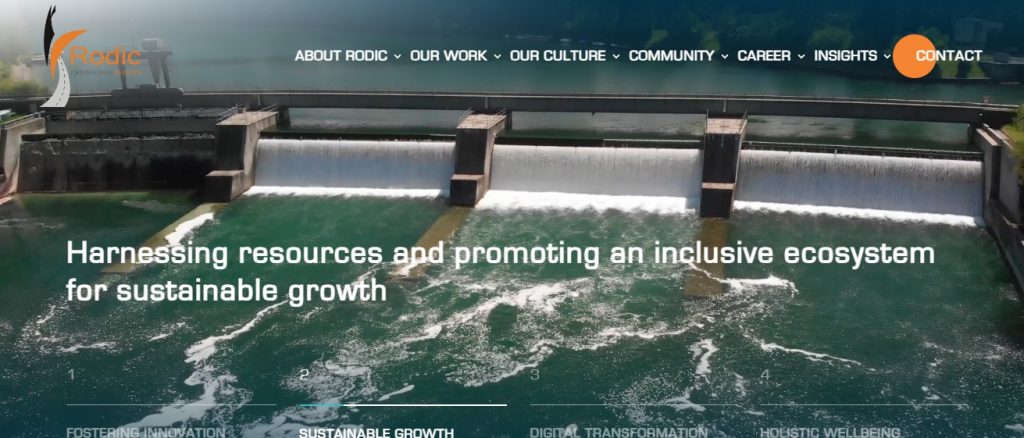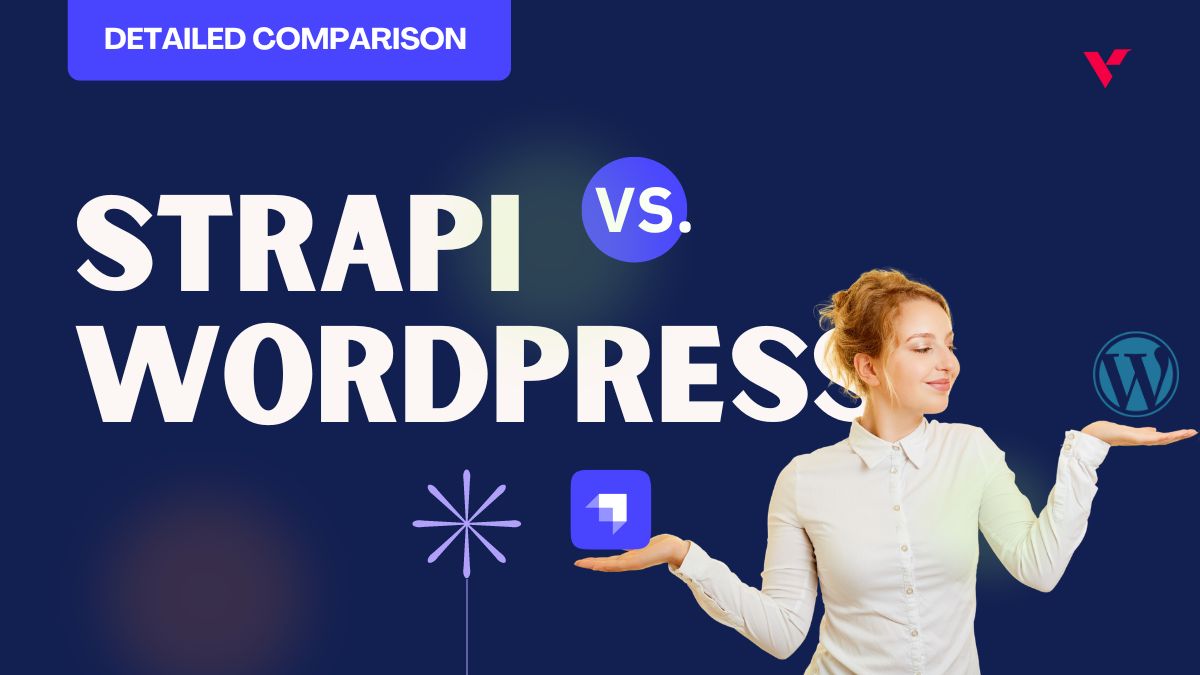As businesses increasingly prioritize digital experiences, the choice of a content management system (CMS) has never been more critical. Strapi, an open-source headless CMS, has emerged as a leader in the space, enabling developers to deliver content across multiple channels with unmatched flexibility. With over 60,000 stars on GitHub and a growing community of developers, Strapi is particularly favored for its API-first architecture, allowing seamless integration with modern front-end frameworks like NextJS, ReactJs, VueJs, and AngularJs.
WordPress remains the most widely used CMS that has drastically evolved in over a decade since its inception and is responsible for powering over 43% of the web. Its vast ecosystem, including more than 59,000 plugins and a decade-long history, makes it a preferred choice for businesses looking to deploy content quickly and efficiently. Despite its traditional architecture, WordPress continues to evolve, with new features and updates catering to the changing needs of website content management.
Table of Contents
Strapi vs WordPress Purpose of Comparison
We’ve initiated this comparison because of the growing need to shift towards more specialized solutions. This comparison between Strapi and WordPress aims to clearly understand which platform is better suited for your specific needs. Whether you’re considering Strapi for its headless capabilities and developer-friendly environment, or WordPress for its comprehensive ecosystem and ease of use, this guide will break down the key features, performance metrics, and real-world use cases. By the end of this analysis, you’ll have a data-driven perspective on which CMS can best support your business objectives and technical requirements. If you’re leaning towards Strapi, you may want to explore our Strapi Development Company services for tailored solutions that fit your project’s needs
What is Strapi?
Strapi is your multi-channel, API first, high-performance, highly flexible, go-to headless CMS, built for those who love flexibility. Launched in 2016, it’s designed to let you manage and deliver content through APIs, so you can pair it with whatever frontend you prefer. Think of it as a CMS that gives you the freedom to build exactly what you want, without the usual constraints.
Core Features
- API-First: Strapi automatically creates RESTful and GraphQL APIs, making it easy to push your content wherever it needs to go.
- Customizable Content: Need custom content types? No problem. Strapi lets you create and customize everything to fit your project’s specific needs.
- User Permissions: Keep things secure by controlling who can see and do what with role-based access control.
- Plugins: Want to add extra features? Strapi has plugins for SEO, integrations, and more to make your life easier.
- Self-Hosting: You get to decide where Strapi lives, so you have full control over your data.
Strapi Headless CMS is the ideal choice for scenarios, where you need to deliver content across multiple channels like websites, mobile apps or IoT devices.
It’s perfect for building custom APIs that seamlessly integrate with your favorite frontend frameworks like NextJS, ReactJs, ReactNative, Vue, and beyond.
That’s not it, Strapi scales easily for big and complex applications with the custom and flexible content management needs.
What is WordPress?
You probably already know WordPress—it’s been around for over 2 decades and powers over 43% of all websites. Originally a blogging platform, it’s now a full-fledged CMS used for everything from personal blogs to large corporate websites. If you need something tried-and-true, WordPress is it.
Core Features
- User-Friendly: Super easy to use, even if you’re not a techie.
- Large Plugin repository: With over 59,000 plugins, you can add just about any feature you can think of.
- Themes and Customization: Tens of thousands of themes and customization options let you create a unique look for your site.
- Content Management: The Gutenberg editor makes it easy to create dynamic, flexible content.
- Strong Community: There’s a massive, active community ready to help with support and resources.
WordPress is perfect for straightforward content-driven websites, blogging, and small businesses looking to get online quickly and easily.
Strapi vs WordPress Key Comparison
| Feature | Strapi | WordPress (Headless) |
| General | ||
| Open Source | Yes | Core is open-source; headless requires plugins |
| Hosting | Cloud + Self-Hosted | Cloud + Self-Hosted (Headless setup) |
| Codebase Language | JavaScript, TypeScript, React | PHP, JavaScript (for custom development) |
| Multi-Database Support | PostgreSQL, SQLite, MySQL, MariaDB | MySQL, MariaDB (native) |
| API & Development | ||
| API-First Approach | Yes (built-in RESTful and GraphQL APIs) | Yes (REST API built-in; GraphQL via plugins) |
| Customizable API | Fully customizable | Yes (with REST API or WPGraphQL) |
| API Playground | Yes | Yes (with GraphQL Playground plugin) |
| JWT Authentication | Yes | Yes (via plugins or custom code) |
| Content Modeling & Management | ||
| Custom Content Types | Yes | No (Possible via plugins or custom code) |
| Custom Fields | Yes | No ( Possible via plugins or custom code) |
| Single Types | Yes | No ( Possible via plugins or custom code) |
| Webhooks | Yes | No ( Possible via plugins or custom code) |
| CRON | Yes | No ( Possible via plugins or custom code) |
| Multi-lingual | Yes | No ( Possible via plugins) |
| Role-Based Access Control | Yes (built-in) | Yes (with custom roles or plugins) |
| Authentication & Permissions | Built-in | No ( Possible via plugins or custom code) |
| Plugins & Ecosystem | ||
| Plugins | Growing ecosystem of plugins | Extensive library of plugins (59K+) |
| Marketplace | Yes | Yes |
| SDK | Yes, Available for various languages | No, But available via third-party libraries |
| Editing Experience | ||
| Previews | Manual setup required | Manual setup required |
| Scheduling | Yes | Yes (built-in) |
| Media Library | Yes | Yes (built-in) |
| Draft & Publish | Yes | Yes (built-in) |
| Collaboration | ||
| Review Workflows | Yes | Yes (with plugins like PublishPress) |
| Versioning | Yes (via plugins) | Yes (with plugins) |
| i18n (Internationalization) | Yes (built-in) | Yes (via plugins like WPML or Polylang) |
| Security & Compliance | ||
| SSO | Yes (via plugins) | Yes (via plugins) |
| Audit Logs | Yes (via plugins) | Yes (via plugins) |
Comparing the Architecture of Strapi & WordPress
Strapi’s Headless Architecture
Strapi is a true headless CMS, designed to decouple the backend from the frontend entirely. This API-first approach, supporting both RESTful and GraphQL APIs, gives developers complete flexibility to deliver content to any platform—whether it’s web, mobile, or IoT—using any frontend framework like React, Vue, or Angular. Strapi’s architecture is ideal for modern, scalable projects that demand customization and control.
WordPress with Headless Capabilities
WordPress started as a traditional, monolithic CMS where the backend and frontend are tightly integrated. However, it can function as a headless CMS through its REST API and plugins like WPGraphQL. While this allows for flexibility, it’s not as seamless as Strapi’s architecture and often requires additional setup. WordPress is better suited for projects that benefit from its extensive plugin ecosystem and are okay with a bit more complexity when decoupling the frontend.
Key Differences
- Decoupling: Strapi is fully decoupled by design, while WordPress can be decoupled with extra effort.
- API-First: Strapi’s API-first nature suits modern projects, whereas WordPress offers APIs through plugins.
- Flexibility: Strapi offers more backend development flexibility; WordPress shines in its plugin ecosystem but may add overhead in headless setups.
- Scalability: Strapi is optimized for API-driven scalability, while WordPress may need extra optimization for high-traffic environments.
- Performance: Strapi’s headless architecture and underlying NodeJS makes it faster.
- Custom Plugin: both allow custom plugin development, however WordPress plugin development is comparatively easier, compared to building a new plugin on Strapi.
Strapi is perfect for projects needing modern, flexible architecture, while WordPress remains a solid choice for those leveraging its traditional strengths with the not very appealing option to go headless.
Development & Customization
Ease of Development
Strapi’s API-First Approach:
Strapi is built with developers in mind, giving more control, offering an API-first approach that makes it straightforward to create, manage, and deliver content. It automatically generates RESTful and GraphQL APIs based on content types; we can immediately focus on frontend development without having to worry about backend complexities like building APIs, Management Interface or authentication.
This approach drastically reduces the time needed to set up a project, making it easier to integrate with any frontend framework like ReactJs, Vue, or Angular. Additionally, Strapi’s user-friendly administration panel is highly customizable, allowing us to personalize the CMS to specific needs without extensive configuration.
This also however means, creating the front end completely from scratch. This is not something that a non-technical user can do on their own. One must have a great hands on experience working with these front end frameworks and integrating with the Strapi APIs for seamless data exchange.
WordPress’s Theme and Plugin Ecosystem:
On the other hand, WordPress is renowned for its extensive theme and plugin ecosystem, which can be a double-edged sword. For us, this ecosystem provides a wealth of pre-built options that can significantly speed up development—whether you’re looking for a ready-made theme or specific functionality via plugins.
While this makes WordPress easy to approach and versatile, it also means developers must navigate a steeper learning curve, particularly when customizing beyond what themes and plugins offer out of the box. Custom development in WordPress often involves working within the constraints of PHP and the existing structure, which can be less flexible than Strapi’s JavaScript-based environment.
But we can’t ignore the fact that it’s possible to set up a basic wordpress website in a matter of hours or days, all this without having to navigate the technical understanding of how things work under the hood.
And this is the reason why it’s a go-to choice for millions of websites today. Strapi can’t beat this.
Comparison of Developer Experience and Learning Curves:
Strapi offers a smoother, more intuitive experience for developers familiar with JavaScript and modern web development practices. Front end development is a completely separate task however.
WordPress, while powerful, can be more challenging for developers who need to go beyond basic customization, as it often requires deeper knowledge of PHP and the WordPress ecosystem.
Customization and Extensibility:
When it comes to customization, its plugin system allows developers to extend its core functionality easily, whether you need to add new features, integrate third-party services, or modify existing behaviors.
Additionally, Strapi supports custom code integration, giving you the freedom to customize your CMS exactly to your project’s needs without being constrained by pre-built components.
WordPress is extensible through its vast plugin ecosystem, covering nearly every imaginable feature—from lead capture, membership functionalities, SEO tools to e-commerce solutions.
This makes WordPress a no-brainer and allows for significant customization without needing to write a lot of custom code. However, the reliance on plugins can also be a double-edged sword; too many plugins can bloat your site, impact performance, and introduce compatibility issues.
Strengths and Weaknesses in Customization Options:
Strapi’s customization is highly flexible, especially for developers who want full control over their CMS, but it requires more technical expertise. ‘
WordPress offers extensive customization through its plugins, making it easier for non-developers to add features, but this can come at the cost of performance and may lead to challenges with plugin conflicts, updates and scalability.
Content Management
User Interface and Experience
Strapi’s Admin Panel:
Strapi offers a clean, developer-friendly admin panel that’s customizable and powerful, allowing for easy creation of custom content types and fields. While it provides great flexibility, it may require a bit more technical knowledge, making it ideal for teams comfortable with more complex setups.
WordPress’s Dashboard:
WordPress’s dashboard is widely recognized for its ease of use, even for non-technical users. It’s intuitive and familiar, offering quick access to all content management features. The dashboard can be further enhanced with plugins and themes, making it extremely user-friendly for content creators and editors who need to manage content efficiently.
Ease of Use for Content Creators and Editors:
Strapi’s admin panel is powerful but might have a steeper learning curve, while WordPress’s dashboard is straightforward and accessible, making it ideal for teams with varying technical expertise.
Content Editing and Workflow
Content Creation and Editing in Strapi:
Strapi allows for highly customizable content creation, tailored to specific project needs. However, it doesn’t offer a visual editor out of the box, focusing more on flexibility and control rather than visual ease of use.
WordPress’s Gutenberg Editor and Visual Builders:
WordPress’s Gutenberg editor revolutionized content creation with its block-based, drag-and-drop interface, making it easy for anyone to create dynamic, visually rich content without coding. For even more control, popular drag-and-drop builders like Elementor and WPBakery allow users to design pages visually, making WordPress exceptionally user-friendly for creating and editing content.
Workflow Management and Collaboration Features:
Strapi provides essential workflow features like versioning and role-based access control but lacks advanced collaboration tools without additional customization.
WordPress excels in this area with its extensive plugins that support editorial workflows, content scheduling, and collaboration, making it a strong choice for teams focused on efficiency and teamwork.
User Experience
Strapi’s User Experience
For Developers:
Strapi is designed with developers in mind, offering a streamlined and flexible environment that allows for rapid development and customization of administration panels and APIs. Its API-first approach means developers have complete control over how content is structured and delivered, which is particularly beneficial for projects requiring a high degree of customization.
The ability to create custom content types and fields without needing to rely on external plugins enhances the developer experience, making Strapi an excellent choice for complex, API-driven projects.
For Content Creators and Editors:
While Strapi’s admin panel is intuitive, it’s more precise. Content creators and editors might find it less visually driven compared to traditional CMS platforms. It does not force content people to use the similar template for all kinds of content. It allows them to have completely tailored forms apt for the content type.
This enhances the usability for teams that require a tailored content management experience.
WordPress’s User Experience
For Developers:
WordPress provides a traditional development experience, particularly for those familiar with PHP and its extensive ecosystem. The vast array of plugins and themes makes it easier to add functionality without extensive coding. However, the dependency on third-party plugins for customization can sometimes lead to challenges with site performance and plugin compatibility, which can cost highly in terms of performance, scalability and architectural limitations.
For Content Creators and Editors:
WordPress excels in its user experience for content creators and editors. The Gutenberg editor offers a block-based, drag-and-drop interface that is highly intuitive, making content creation accessible even to those with little technical expertise.
Additionally, popular drag-and-drop page builders like Elementor further enhance the user experience, allowing for easy design and layout customization without any coding. This makes WordPress an ideal choice for teams that prioritize ease of use and visual content management. This highly celebrated freedom however, can also lead to broken layouts if not used properly.
Performance and Scalability
Performance Benchmarking
Load Times and Response Times:
Strapi’s headless architecture leads to much faster load times and quicker response rates because the backend is decoupled from the frontend, allowing for independent optimization. This is particularly effective when paired with modern frontend frameworks.
Handling Large Volumes of Traffic:
Strapi efficiently manages high traffic volumes by leveraging CDNs and API-specific caching, maintaining performance even during traffic spikes.
WordPress Performance:
WordPress can face performance challenges due to its monolithic nature, but with proper optimization—like caching plugins, CDNs, and database tuning—it can handle heavy loads. In headless setups, WordPress can also improve performance, though it requires more configuration.
Scalability
Strapi’s Scalability:
Strapi scales well with growing content and traffic, let’s credit its ability to add more server instances as needed, making it ideal for constantly expanding projects.
WordPress’s Scalability Challenges:
WordPress can scale, but it often requires careful management, such as optimizing the database, using load balancers, and ensuring plugins are performance-friendly. Headless WordPress setups can also improve scalability but need additional resources and setup.
Security
Security Features in Strapi
Default Security Practices:
Strapi boasts strong default security practices, including role-based access control (RBAC), JWT authentication, and API token management. These features ensure that only authorized users can access and manage content. Strapi also allows precise permissions, making it easy to manage user roles and API access securely.
API Security:
Strapi focuses on API security by providing built-in mechanisms to protect API endpoints from unauthorized access. It supports HTTPS and offers options to configure CORS, rate limiting, and other security headers to safeguard your API communications.
Common Vulnerabilities and How Strapi Addresses Them:
Strapi is designed to minimize common vulnerabilities such as SQL injection, cross-site scripting (XSS), and unauthorized access. The platform regularly updates its security protocols and provides guidelines to developers for maintaining secure configurations.
Security Features in WordPress
Security Through Plugins:
WordPress relies heavily on plugins for security, with popular options like Wordfence and Sucuri providing firewalls, malware scanning, and login protection. Frequent updates from the WordPress core team help patch vulnerabilities as they arise.
Frequent Updates and Community Support:
WordPress regularly releases updates to fix security vulnerabilities, and the vast plugin ecosystem often includes security enhancements, but it can add to the overhead of keeping the WordPress core and it’s plugin uptodate and often break what’s already working owing to the incompatible updates.
Common Vulnerabilities in WordPress and How to Mitigate Them:
WordPress is prone to vulnerabilities such as brute force attacks, outdated plugins, and insecure themes. Mitigation strategies include using strong passwords, regularly updating plugins and themes, employing security plugins, and hosting on secure servers with SSL certificates.
Strapi’s built-in security features provide a robust foundation, while WordPress offers extensive options through plugins and community support but requires more proactive management to mitigate common risks.
SEO Capabilities
SEO in Strapi
Managing SEO in a Headless CMS:
In Strapi, SEO is all about customization. Since it’s headless, you control how SEO is implemented directly in your frontend. You can set up custom fields for meta tags, titles, and descriptions, giving you full flexibility.
Tools and Best Practices:
Pair Strapi with SEO-friendly frontend frameworks like NextJs or Gatsby. Create custom fields for SEO elements and use tools like sitemap generators and analytics integrations to keep everything optimized. At VOCSO we love how it allows our front end developers to leverage programmatic SEO.
SEO in WordPress
Built-in SEO Features:
WordPress makes SEO easy with built-in features and popular plugins like Yoast SEO. You can manage meta tags, sitemaps, and get real-time SEO tips directly from your dashboard—perfect for non-tech users.
Strengths and Limitations:
WordPress is great for quick SEO setup with minimal effort. However, relying on multiple plugins can slow down your site and lead to conflicts. It’s simple for traditional sites but might need extra tweaking for headless setups.
In short, Strapi gives you full control and flexibility for SEO in a headless setup, while WordPress offers a more plug-and-play approach that’s easy to manage but might require careful handling of plugins.
Ecosystem and Community Support
Strapi’s Ecosystem
Community and Support:
Strapi’s community is growing, with active forums, GitHub, and Discord channels. Support includes official and third-party plugins, though the ecosystem is still expanding.
Plugins:
Offers a range of official and third-party plugins, but it’s less extensive than older platforms.
WordPress Ecosystem
Community and Support:
WordPress has a large, active community with extensive forums, themes, and plugins. It offers rich support through various channels and a vast knowledge base.
Themes, Plugins, and Forums:
Thousands of themes and plugins, with strong support forums and developer resources.
Strapi’s ecosystem is growing, but WordPress’s community and resources are much larger and more established, providing broader support and more options.
Cost Considerations
Cost of Using Strapi:
Strapi is open-source, which means you can use it for free. However, you’ll need to factor in hosting costs and development expenses, especially if you require custom features or integrations. While Strapi itself has no licensing fees, the overall cost depends on your hosting solution and development needs. In addition, developing the front end application is a completely different cost.
Ideally, the cost of building and managing your applications/websites on Strapi will attract higher costs, owing to its modern NodeJS based ecosystem.
Cost of Using WordPress:
WordPress is also free, but costs can add up with premium themes, plugins, and hosting services. For small businesses or individual users, these costs are generally manageable, but enterprises might face higher expenses due to advanced plugins or custom development.
Strapi vs WordPress: Who is the Winner?
Strapi is our new found love here at VOCSO, but I’m going to try and remain less biased 😉
Both platforms have their strengths and are well-suited for different use cases. Strapi meets the expectations in scenarios where flexibility, modern architecture, and API-driven development are crucial. Its headless CMS approach provides extensive customization and control over content delivery, making it ideal for complex, data-driven applications and projects that require integration with various frontend technologies.
WordPress, on the other hand, excels in traditional content management with its extensive ecosystem of themes and plugins. It’s particularly strong for straightforward websites, blogs, and small businesses that benefit from its user-friendly interface and robust community support.
Strapi & WordPress Use Case comparison
| Use Case | Strapi | WordPress |
| Headless CMS Projects | ✔️Excellent for API-driven, multi-channel delivery | ❌Limited, more traditional CMS setup |
| Custom APIs and Integrations | ✔️Ideal for custom APIs and modern tech stacks | ❌Less flexible, more reliant on plugins |
| Traditional Websites | Good, but overkill for simple sites | ✔️Ideal for straightforward websites |
| Blogging | ✔️Yes, but not its core strength | ✔️Excellent, with extensive blogging tools |
| Small Businesses | ✔️Great for modern, scalable solutions | ✔️Quick setup, easy to manage |
| Enterprise Solutions | ✔️Strong for complex, data-rich applications | ❌Good, but may require custom development |
| E-commerce | ✔️Possible with additional development | ✔️Strong support through plugins |
| Corporate Websites | ✔️ Suitable for high-performance, customizable sites | ✔️ Good for standard corporate needs |
| Single Page Applications (SPAs) | ✔️ Works well with modern front ends like ReactJs or Vue | ❌ Not ideal for SPAs without additional plugins |
| Content Portals | ✔️ Efficient for managing diverse content types | ✔️ Manageable, but may require extensive plugins |
| Learning Management Systems (LMS) | ✔️ Adaptable for custom learning solutions | ✔️ Possible with LMS plugins |
| Event Management Systems | ✔️ Flexible for custom event features | ✔️ Manageable with event plugins |
| Community Platforms | ✔️ Customizable with specific features for community engagement | ✔️ Good with existing community plugins |
| Mobile Applications | ✔️ Easily integrates with mobile apps via APIs | ❌ Requires plugins and custom setup for mobile integration |
| Real-Time Applications | ✔️ Supports real-time features with custom development | ❌ Not inherently built for real-time; requires additional plugins |
| Social Media Applications | ✔️ Flexible for custom social media features | ❌ Requires extensive customization; not ideal for complex social features |
| Membership Websites | ✔️ Adaptable for custom membership features | ✔️ Supported with various membership plugins |
Strapi NextJS Case Studies
Colleges18: “Explore our Colleges18 case study to see how we built a dynamic college discovery platform using Strapi and Next.js. Highlights include over 12,000 colleges listed, a user-friendly interface, and a scalable solution that handles high traffic seamlessly.”

Schools18: “Discover the Schools18 case study where we developed a robust school search platform. Key highlights: more than 20,000 schools indexed, a loading time of under 3 seconds, and optimized for high user engagement and lead generation.”

Rodic Consultants: “Check out our portfolio for Rodic Consultants to see the tailored UI/UX design solutions we provided. Highlights include a modern interface, enhanced user experience, and a design that reflects their industry expertise and innovative approach.”

Which one should you use for your next project?
Choosing between Strapi and WordPress? It depends on your project’s needs. If you need flexibility, custom APIs, and scalability powered by a modern tech stack, Strapi is a strong choice. For traditional sites, blogging, or easy content management, WordPress might be better.
Unsure which fits your project? Contact VOCSO to discuss your options and get expert advice tailored to your needs.
FAQs Strapi vs. WordPress



















